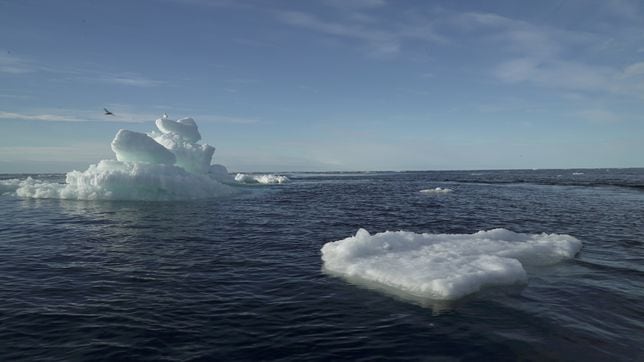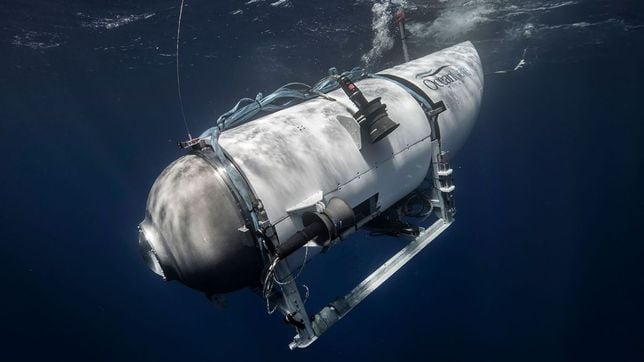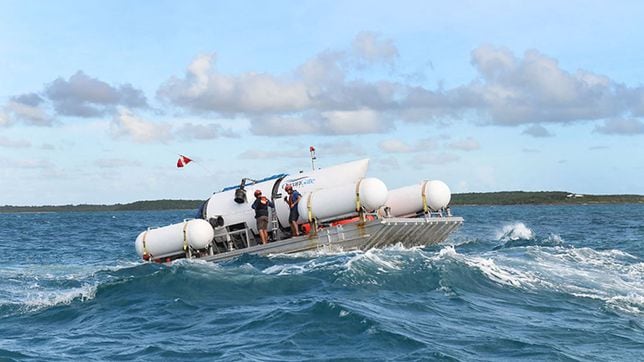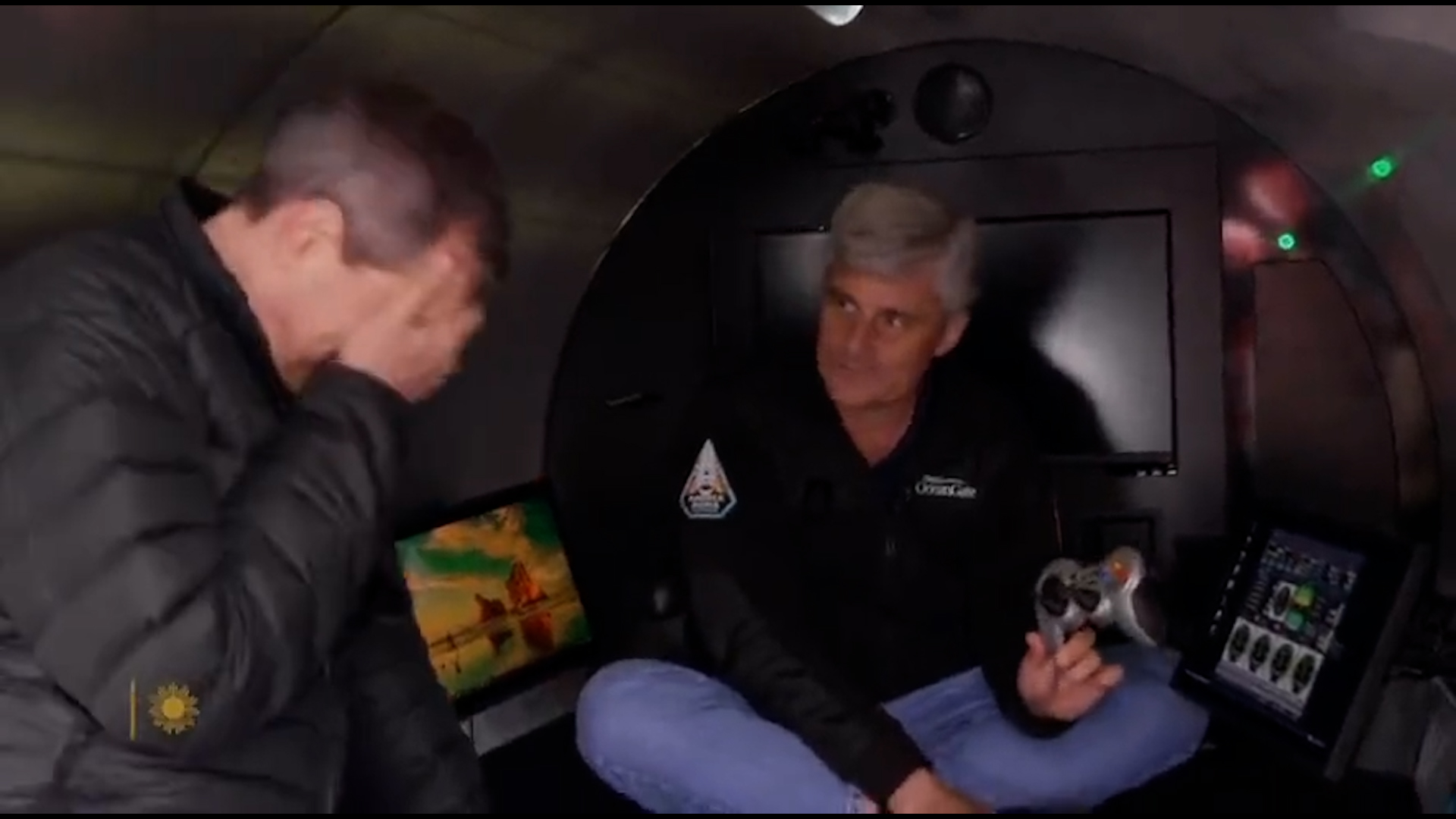Titanic expedition search news summary | 21 June
The Titan submarine has still not been located as time is running out for saving the five passengers onboard, though sounds from the deep offer hope.


Show key events only
Titan Search and Rescue: Latest Updates
Headlines | Thursday, 22 June 2023
- The race against the clock intensifies as the Titan's estimated oxygen supply enters the last few hours.
- New reporting shows that OceanGate executives were warned about the risks of the voyage and ignored calls to increase safety
- US Coast Guard confirms that "banging" noise identified did not come from the Titan
- Human rights activists call attention to stark inequalities between those on the Titan and the aid provided to migrants who perished in the Mediterranean earlier this month.
- The cost of the Titanic expedition
- What you need to know about the sinking of the Titanic
Read more from AS USA:
Wife of OceanGate pilot is descendent of Titanic victims
The New York Times have reported that Wendy Rush, a communications director for OceanGate and the wife of sub pilot Stockton Rush, is in fact the great-great granddaughter of Titanic victims Isidor and Ida Straus.
"Ms. Rush’s ancestors on the Titanic are perhaps best known for their tragic love story. Survivors of the disaster recalled seeing Isidor Straus refuse a seat on a lifeboat when women and children were still waiting to flee the sinking liner. Ida Straus, his wife of four decades, declared that she would not leave her husband, and the two were seen standing arm in arm on the Titanic’s deck as the ship went down".
In the 1997 movie, there is a scene which depicts an older couple embracing as water levels rise within the cabin, which is thought to be Ida and Isidor.
"It may take a a few hours to release the sub from the seafloor"
Deep-sea engineer Ron Allum, who designed the vessel that film-maker James Cameron used to reach the Mariana Trench, the Earth's deepest point, says that it's unlikely the Titan submersible "suffered a catastrophic failure of its pressure hull".
Speaking to The Guardian, Allum expanded:
“Sound travels particularly well underwater. A catastrophic implosion could be heard for thousands of miles and could be recorded. To me, it sounds like the sub’s pressure hull is intact, but it’s demobilised from power.
“If the pressure hull is flooded, you’re now talking about the dry mass of a vessel. You could be lifting a very heavy weight,” Allum said.
“If it were intact, an ROV [remotely operated vehicle] could attach to it and it could at least bring it up to shallower water where they could get a stronger lift cable to it to lift it out of the water… that ascent may take an hour or two.
“The ROV may have to work around the wreckage… it may take a few hours to release the sub from the seafloor.”
Time, unfortunately, is on nobody's side.
Estimates of four to five hours of oxygen left for Titan passengers
When the Titan set off on Sunday, the crew had a four-day oxygen supply. Sadly, it is now estimated that that has run down to between four and five hours.
Difficulty of Titan rescue mission illustrated
To say that the seas and oceans of the world are 'deep' isn't exactly groundbreaking or descriptive enough. Instead, here's a fascinating visualisation that illustrates just exactly how 'deep' they are and just how difficult a rescue mission is.
Victor 6000 robot to search for Titan
The Victor 6000 robot from France appears to be the last hope of finding the missing submersible, as it is able to reach the depths at which the Titanic is located.
However, with only a few hours left on the Titan's air supply, hope is dwindling that the passengers will still be found alive.
Titan passenger talks about dangers of submersibles in earlier interview
In a 2019 interview, Paul-Henri Nargeolet, one of the passengers of the ill-fated submersible the Titan, spoke about the possibility of dying while inside a vessel that is deep underwater.
He mentions that aside from running out of air, the temperature is likely to kill you.
People anxious for news on Titan rescue efforts
As the air supply dwindles in the missing submersible, the Titan, people are anxious to hear about how the search operations are going.
Tracking is up for a plane employed by the US Coast Guard to help in rescue operations.
Time is running out for rescue teams working to find the Titan submersible that lost communication underwater, as it was heading towards the remains of the Titanic at a depth of 12,400 feet. They are still trying to assess the feasibility of a rescue mission, as the five crew members of the ship had a maximum of 96 hours of oxygen, which runs out tomorrow. This means that there are only a few hours left in which there is still a possibility, however remote, of recovering the unfortunate passengers alive. Among them is Stockton Rush, the executive director of the submersible’s maker, OceanGate.
It seems highly unlikely that the lives of the five on board can be saved at this point. Among other things, because a recovery operation at these depths - even if the exact location of the vehicle was known - can last for days. And, as already noted, there is not much air supply left in the small cabin. Therefore, barring a miracle, it seems that the maneuvers of the authorities will serve, at most, to recover the remains.
Read more on the warnings about the high risks of the voyage that were known by company executives for years before this week's tragic events.
As many in the United States and Europe have their attention drawn to the missing submersible, dubbed the Titan, carrying five people to the wreckage of the Titanic, there is another tragic story that took place at sea earlier this month that the media almost entirely missed.
Earlier this month, off the coast of Greece in the Mediterranean Sea, a boat that set sail for Italy from Libya carrying between 400 and 700 migrants capsized. To date, the International Organization for Migration has confirmed seventy-eight deaths but believes this figure is likely much higher. A UN Human Rights agency reported on 16 June that five hundred migrants, including “large numbers of women and children,” were still missing and that only 104 people had been rescued. Since then, three more bodies have been recovered. The death count has yet to be finalized, but the horrific incident is likely to be one of the most deadly cases in EU migratory history.
Read more in our full coverage on how activists and academics have responded to the stark differences in aid provided to those lost on the Titan and the hundreds of migrants who perished on the Mediterranean.
The missing submersible, the Titan, is in an extremely difficult situation. First, only a handful of vessels are capable of withstanding the pressures of sea depths more than 12,400 feet where the Titanic is located. Second, there are very few historical examples of rescue missions in similar circumstances. Those responsible for the recovery operation want to be prepared for any eventuality, so they consider all possible hypotheses, whether they have positive or fatal outcomes.
Read more in our full coverage on the status of the search and rescue mission.
Hope is fading for the five crew members of the OceanGate vessel Titan which lost contact with its mothership on Sunday and vanished without a trace 3,800 meters beneath the Atlantic Ocean. A rescue/recovery operation is underway with the Canadian military and US Coast Guards combing the area, with the slim possibility that the vessel might have surfaced, although that seems unlikely as all of those on board had smartphones with them and would have messaged for help by now.
Titan, which was manufactured by OceanGate Enterprises is classed as a submersible and not a submarine. The difference being that a submarine has enough power to launch itself from port and return to port by its own means while a submersible relies on a mothership or support vessel that can launch it, recover it and in Titan’s case, guide it.
Read more on the difference in our full coverage.
US Coast Guard confirms that the "banging" noise identified did not come from the Titan
After the search and rescue team picked up noises that resembled banging, many hoped the vessel could be identified in time to save those trapped inside. However, the US Coast Guard confirmed this afternoon that after investigating the origin of the sound, it did not come from the Titan.
Noises identified in search and rescue zone have not been confirmed as coming from the Titan
Officials have reported that sounds resembling pounding on a hard surface were picked up during the ongoing search and rescue mission for the missing submersible, Titan. However, representatives from the US Coast Guard have clarified that there has been no confirmation that these sounds were from the vessel. The natural rhythms of the ocean could be one of the many possibilities behind the sounds. Although it is a positive sign, it should not be taken as confirmed.
US Coast Guard provides update on Titan search and rescue mission
Officials from the US Coast Guard provided an update on the status of the search and rescue mission that continues after the Titan, a submersible carrying five tourists to the wreckage of the Titanic, went missing on Sunday.
Families of the individuals aboard the vessel are receiving regular updates, and US officials are communicating with their counterparts from France and Britain as citizens from these countries are among those who are currently unaccounted for.
Assistance from various governments has played a crucial role in aiding the Coast Guard's search efforts, as the search area for the Titanic is extensive and deep. With the vessel resting 12,500 feet below the ocean surface, the search operation requires a wide and lengthy "net" to locate the wreckage.
According to reports from officials, additional search equipment is expected to arrive tomorrow, including several aerial support units. This comes after an aircraft detected underwater sounds believed to be coming from the missing vessel. As a result, search efforts will now be concentrated on this area, while continuing to explore the wider zone.
OceanGate Expeditions has been operating deep-ocean expeditions since 2009. Over the years, it has carried out more than 200 dives with its three submersible vessels in the Atlantic, Pacific and Gulf of Mexico. Titan, which went missing on Sunday, is designed to go the deepest of them all, able to reach depths of over 13,000 feet, or 4,000 meters, according to the company.
The craft was on a dive to explore the wreckage of the Titanic, resting on the Atlantic Ocean floor around 12,500 feet below sea level, with five tourists aboard when communication with it was lost. It wasn’t the vessel’s first trip to the Titanic, earlier expeditions had been planned as far back as 2018, but technical and regulatory snags had prevented them from being carried out.
Read more in our full coverage on how many journeys to the site of the wreckage had been made.
French robot Victor 6000 arrives at the scene to support Titan search and rescue
A four-ton robot from France called the Victor 6000 has arrived at the site of the search and rescue for the Titan submersible that went missing on Sunday. The vessel was on its way to tour the wreckage of the Titanic when it lost communication with the mainland less than two hours after departing.
The Victor 6000 can travel 20,000 feet underwater, and paired with a US craine the officials in charge of the mission hope that it would be able to identify the Titan and bring it to the surface. However, the situation is unprecedented and there are still doubts that that it would be able to carry the sub to the ocean's surface.
Why so much focus on one submarine?
Alongside the constant media coverage of this submarine rescue, people on social media have been questioning why it is getting so much attention.
Indeed, there have been other serious seaborne tragedies in the last week. In Greece, a ship carrying hundres of migrants went down in the Mediterranean sea with some estimates have up to 500 children dead. There was not the intense rescue mission like that seen today leading some to question why billionaires are receiving preferential treatment compared to societies poorest.
The company OceanGate Expeditions confirmed through an official statement that the people on board the Titan submarine are Hamish Harding, Shahzada Dawood and his son Suleman, Paul-Henri Nargeolet and Stockton Rush.
These are the people still stranded.
Less than a day of oxygen still remaining for submarine - US coast guard admiral
Rear Admiral John Mauger has told BBC News that the crew on board the Titanic submersible may have less than 20 hours of oxygen left.
"One of the factors that makes it hard to predict how much oxygen is left is that we do not know the rate of the consumption of oxygen per occupant on the sub."
Local time this means rescuers have until tomorrow morning to find the sub.
The noises at the centre of the search
Earlier the US Coast Guard confirmed that an aircraft had picked up noise from the ocean, but Rear Admiral John Mauger - who is leading the coast guard mission -said there were a lot of metal objects at the Titanic site that could have been causing the banging.
Noises give hope this is still a rescue operation - oceanographer
There are plenty of sound sources in the ocean, but it does give hope. I think one of the scenarios that everyone feared was that the submersible had basically imploded. So it does give some hope that this is still a rescue operation, rather than just a recovery operation.
24 hours of oxygen left say coast guard
Capt Jamie Frederick from the First Coast Guard District has had a press conference on Tuesday afternoon.
He said there is about 40 hours of breathable air left on the sub, based on the initial reports of 96 hours left. This number is now down to 24 hours
Last year, the Titan, the submarine which has now been missing since Sunday, went on a similar expedition to see the remains of shipwrecked Titanic. CBS correspondent David Pogue accompanied the crew at that time, along with New York-based writer Mike Reiss. That time, the Titan also went missing, though only for a few hours.
In a CBS story, Pogue spoke about the deep sea vessel, operated by a company called OceanGate Expeditions, and said there were some parts that seemed “improvised”, including the fact that it was controlled by a reinforced Playstation controller.
The Titan's uncertified specs
Reports have been coming out that the missing submersible, the Titan, did not pass safety regulations. According to a story by The New Republic, the vessel was far from being certified for the pressure that it would withstand at the depths it intended to reach.
The company's mission brief also made reference to the vessel not conforming to regulations.
More help on the way for search for missing submersible
More vessels are on their way to assist in search operations for the missing submersible, the Titan.
Focus has been mostly surface sweeps, but more resources will now be given to underwater searches, including an exploration robot from France.
Aircraft heard sounds from the area where sub disappeared
A report by Rolling Stone says that an aircraft heard sounds at 30-minute intervals from the area where the sub disappeared, per internal e-mails sent to DHS leadership obtained by the magazine.
“The P8 deployed sonobuoys, which reported a contact in a position close to the distress position. The P8 heard banging sounds in the area every 30 minutes. Four hours later additional sonar was deployed and banging was still heard,” according to the DHS emails.
Hello and welcome to AS USA's live feed covering the ongoing case of the missing submersible that was headed to view the wreckage of the Titanic. The Titan, the name of the vessel in question, lost communication with the mainland less than two hours after departing on Sunday, 20 June.
The company running the trip, OceanGate Expeditions, has provided periodic updates on the status of the search and rescue mission.




/cloudfront-eu-central-1.images.arcpublishing.com/diarioas/W24E77SCRRYH5N5DVJQ42IZODY.jpg)




